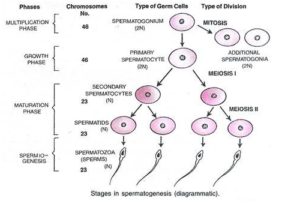MCQ ON Gametogenesis events for NEET |MCQ ON Gametogenesis NEET Biology class 12 th |MCQ Questions for class 12 Biology chapter 2,Gametogenesis with answer | Check the below NCERT MCQ question for class 12 Biology chapter 1 based on Gametogenesis with answers.
MCQ Questions for class 12 Biology with Answers were prepared based on the latest pattern. We have provided class 12 Biology MCQ questions on Gametogenesis with answers to help students understand the concept very well.

Gametogenesis events
MCQ on is useful for NEET/ CSIR/ UGC/ CBSE/ ICSE /AIIMS EXAM/ AFMC EXAM/ JAC exam/ STATE LEVEL MEDICAL EXAM
Introduction:-
Gametogenesis:- Gametogenesis is the biological process by which specialized reproductive cells, known as gametes, are produced. Gametes are essential for sexual reproduction in many organisms, as they carry half of the genetic information necessary for the formation of a new individual. In humans, gametogenesis results in the formation of two types of gametes: sperm in males and eggs (ova) in females.
The process of gametogenesis involves a series of cell divisions and differentiation steps. Here’s a brief overview of gametogenesis in humans:
1. Spermatogenesis (in males):
– Spermatogenesis begins at puberty and continues throughout a male’s life.
– It takes place in the testes, specifically within structures called seminiferous tubules.
– Diploid cells called spermatogonia undergo mitotic divisions to produce primary spermatocytes.
– Primary spermatocytes undergo meiosis, resulting in the formation of haploid secondary spermatocytes.
– Secondary spermatocytes further divide to form spermatids.
– Spermatids then undergo structural changes and maturation to become spermatozoa (sperm cells).
2. Oogenesis (in females):
– Oogenesis begins during fetal development and continues until menopause, but most eggs are arrested in an immature state until puberty.
– The process occurs within the ovaries.
– Unlike males, females are born with a finite number of primary oocytes in their ovaries.
– Prior to birth, primary oocytes undergo the first meiotic division, but they are arrested in prophase I until puberty.
– After puberty, one primary oocyte is typically activated and completes meiosis I, resulting in the formation of a secondary oocyte and a smaller polar body.
– The secondary oocyte is arrested in metaphase II and is only fully fertilized if it encounters a sperm.
In both males and females, gametogenesis is essential for the production of mature, functional gametes capable of fertilization. These gametes, the sperm and eggs, carry unique combinations of genetic information, contributing to genetic diversity in offspring during sexual reproduction.
MCQ ON Gametogenesis events for NEET
Here are 15 multiple-choice questions (MCQs) related to gametogenesis, along with their answers:
1. What is the primary purpose of gametogenesis?
a) Growth
b) Digestion
c) Gamete formation
d) Respiration
Answer: c) Gamete formation
2. In humans, where does spermatogenesis occur?
a) Ovaries
b) Testes
c) Uterus
d) Fallopian tubes
Answer: b) Testes
3. What is oogenesis?
a) The formation of sperm
b) The formation of eggs (ova)
c) The fusion of sperm and egg
d) The development of embryos
Answer: b) The formation of eggs (ova)
4. Which of the following is NOT a gamete in humans?
a) Sperm
b) Egg (ova)
c) Zygote
d) None of the above
Answer: c) Zygote
5. What type of cell division is involved in spermatogenesis?
a) Mitosis
b) Meiosis
c) Binary fission
d) Budding
Answer: b) Meiosis
6. How many functional sperm are typically produced from one primary spermatocyte?
a) 1
b) 2
c) 4
d) 8
Answer: c) 4
7. In females, when does oogenesis begin?
a) At birth
b) At puberty
c) During pregnancy
d) At menopause
Answer: a) At birth
8. What is the result of spermatogenesis?
a) Formation of eggs
b) Formation of sperm
c) Formation of zygotes
d) Formation of embryos
Answer: b) Formation of sperm
9. Which of the following statements about gametogenesis is true?
a) It occurs throughout an individual’s life.
b) It produces diploid cells.
c) It involves only mitosis.
d) It is the same in males and females.
Answer: a) It occurs throughout an individual’s life.
10. What is the primary outcome of meiosis in oogenesis?
a) Two eggs (ova)
b) One egg (ova)
c) Four eggs (ova)
d) Eight eggs (ova)
Answer: b) One egg (ova)
11. When does oogenesis usually pause and then resume in females?
a) At birth and resumes at puberty
b) At puberty and resumes during pregnancy
c) During pregnancy and resumes at birth
d) At menopause and never resumes
Answer: a) At birth and resumes at puberty
12. Which of the following is a characteristic of primary oocytes?
a) They are haploid.
b) They are produced continuously.
c) They are arrested in prophase I of meiosis.
d) They are the result of fertilization.
Answer: c) They are arrested in prophase I of meiosis.
13. What is the term for the process by which a primary oocyte develops into a mature egg?
a) Ovulation
b) Fertilization
c) Maturation
d) Meiosis
Answer: a) Ovulation
14. What is the fate of most primary oocytes in females?
a) They develop into mature eggs.
b) They undergo apoptosis (cell death).
c) They remain arrested in prophase I indefinitely.
d) They divide by mitosis.
Answer: b) They undergo apoptosis (cell death).
15. Which of the following is essential for sexual reproduction but not for asexual reproduction?
a) Gametogenesis
b) Mitosis
c) Binary fission
d) Budding
Answer: a) Gametogenesis
Conclusion:-
MCQ ON Gametogenesis events for NEET |In females, when does oogenesis begin?a) At birth, b) At puberty, c) During pregnancy, d) At menopause, Answer: a) At birth







Leave a Comment